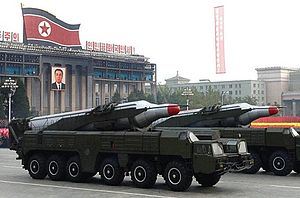- BM25 Musudan
-
Taepodong X 
Type Ballistic missile, Mobile IRBM, SLBM Service history In service Tested successfully 5 Apr, 2009 (as Unha's 2nd stage) Used by North Korea, Iran Production history Manufacturer  North Korea
North KoreaSpecifications Weight 12,000 kg Length 12 m Diameter 1.5 m Warhead Conventional
NuclearEngine Liquid Propellant storable Operational
range3,000–4,000 km (est.)[1] Guidance
systemInertial Launch
platformMAZ-based vehicle, modified Romeo or Golf class submarines Korean name Chosŏn'gŭl 무수단 Hancha 舞水端 McCune–Reischauer Musutan Revised Romanization Musudan The Taepodong X,[2] also known under the names Nodong / Rodong-B, Mirim and BM25 Musudan is a mobile intermediate-range ballistic missile developed by the Democratic People's Republic of Korea, based on Soviet Union's R-27 Zyb. The missile probably makes up the 2nd stage of Taepodong-2, a fixed-launch-platform ICBM. The Taepodong X was first revealed to the international community in a military parade on 10 October 2010 celebrating the Korean Worker's Party's 65th anniversary.
Contents
Development
In the mid-1990s, after the collapse of the Soviet Union, North Korea invited the Makeyev Design Bureau's ballistic missile designers and engineers to develop this missile, based on the R-27 Zyb.
It was decided that, as the Korean People's Army's MAZ-547A/MAZ-7916 Transporter erector launcher could carry 20 tonnes, and the R-27 Zyb was only 14.2 tonnes, the R-27 Zyb's fuel/oxidizer tank could be extended by approximately 1.7 m.[1] Additionally, the warhead was reduced from a three-warhead MIRV to a single warhead.
It was estimated that, as a result of the tank extension and warhead replacement, the missile's range was approximately 3,200-4,000 km, an improvement on the R-27U's 3,000 km.[3]
The actual rocket design is a liquid fuel rocket using a hypergolic combination of unsymmetrical dimethylhydrazine as fuel, and inhibited red fuming nitric acid as oxidizer; this fuel/oxidizer combination does not vaporise like liquified hydrogen/oxygen gas at 35°C. As a result, once the fuel/oxidizer combination were fed into the missile, it could maintain a 'ready to launch' condition for several days, or even weeks, like the R-27 SLBM; however it could not be kept longer than this, because of tank corrosion caused by the red fuming nitric acid.
Musudan's rocket motors originally made up either the 1st or 2nd stage of the Taepodong-2, which North Korea test fired in 2006. However, this launch was not successful. The TD-2 first demonstrated a successful test launch on July 5, 2009, proving the reliability of the Musudan missile.[4]
According to other sources though, the Taepodong-X missile, with a range of up to 4,000 kilometers, is a solid-fuel missile, not a liquid-fuel one, and is still in development as of 2009.[5] However, 16 launchers with missiles were displayed in the 10 October 2010 military parade, the largest in the country's history.
Description and technical specifications
The North Korean R-27 copy exists in two variants—a land-based and a sea-based variant. Current deployment numbers of either variant remains unknown.
Musudan
- Launch weight: 20,654 kg
- Diameter: 1.50 m
- Total Length: 12 m
- Payload: 1,000 kg
- Warhead: single
- Maximum range: 3,000–4,000 km
- CEP: 1.3 km
- Launch platform: North Korean-produced TEL, resembling a stretched and modified MAZ-543; cargo ships or modified submarines
Operators
 North Korea: According to one source, more than 200;[6] other source claims 12 deployed.[7]
North Korea: According to one source, more than 200;[6] other source claims 12 deployed.[7] Iran: 19, according to a leaked, classified U.S. State Department cable.[8]
Iran: 19, according to a leaked, classified U.S. State Department cable.[8]
Section 25 of this leaked cable[9] says:
Russia said that during its presentations in Moscow and its comments thus far during the current talks, the U.S. has discussed the BM-25 as an existing system. Russia questioned the basis for this assumption and asked for any facts the U.S. had to provide its existence such as launches, photos, etc. For Russia, the BM-25 is a mysterious missile. North Korea has not conducted any tests of this missile, but the U.S. has said that North Korea transferred 19 of these missiles to Iran. It is hard for Russia to follow the logic trail on this. Since Russia has not seen any evidence of this missile being developed or tested, it is hard for Russia to imagine that Iran would buy an untested system. Russia does not understand how a deal would be made for an untested missile. References to the missile's existence are more in the domain of political literature than technical fact. In short, for Russia, there is a question about the existence of this system.
See also
- National missile defense, for U.S. counter-measures
References
- ^ Bulletin Staff, Bulletin (March/April 2003). "How terrible the Taepo? (within "North Korea: Less than meets the eye")". "Bulletin of the Atomic Scientists" 59 (2): 38. doi:10.2968/059002010. http://thebulletin.metapress.com/content/qx3t362441754305/?p=01e8e607ad824a958cd9556236d0a873&pi=9. Retrieved 2009-08-05.
- ^ Iranian Missile Tech Appears in North Korea, AviationWeek, 14 October 2010
- ^ 13P
- ^ 2nd 3rd Right Side
- ^ Taepodong-X missile, Deagel.com
- ^ http://www.rfa.org/english/news/korea/missiles-10132010181348.html North’s Missiles Raise Concerns, Radio Free Asia, 13 October 2010
- ^ North Korea Rolls Out Ballistic Missiles, Global Security Newswire, 13 October 2010
- ^ William J. Broad; James Glanz; David E. Sanger (28 November 2010). "Iran Fortifies Its Arsenal With the Aid of North Korea". The New York Times. http://www.nytimes.com/2010/11/29/world/middleeast/29missiles.html?_r=1. Retrieved 28 November 2010.
- ^ "10STATE17263". http://www.win.tue.nl/~aeb/soc/wl/10STATE17263.html.
External links
Short-range KN-2 · Hwasong-5 · Hwasong-6Medium-range ICBM Space launch vehicles Paektusan · UnhaCategories:- Ballistic missiles of North Korea
- Intermediate-range ballistic missiles of the Soviet Union
- Submarine-launched ballistic missiles of the Soviet Union
- Ballistic missiles of Iran
Wikimedia Foundation. 2010.
